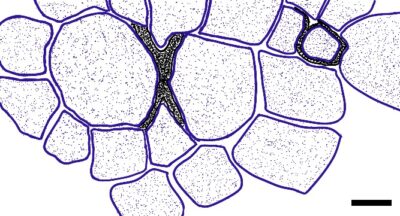Fungalpedia – Note 406, Palaeoendogone
Palaeoendogone Strullu-Derr. & Strullu
Citation when using this data: Tibpromma et al. 2024 (in prep.) – Fungalpedia, Mucoromycota.
Index Fungorum, Facesoffungi, MycoBank, GenBank, Fig. 1
Classification: Incertae sedis, Incertae sedis, Incertae sedis, Incertae sedis, Mucoromycotina, Mucoromycota, Fungi.
Octosporopsis was introduced by Strullu-Derrien et al. (2014) as a monotypic genus within Mucoromycotina to accommodate the type species Palaeoendogone gwynne-vaughaniae (basionymized with Humaria nicolai), based on morphology. Currently, only one species is accepted in this genus, which is endophytic in the corm of Horneophyton lignieri (fossilized plants) in Scotland (Strullu-Derrien et al. 2014). This genus is mainly characterized by aseptate intercellular branched thin-walled and intercellular thicker-walled hyphae present in the corm of the plant, which form intracellular coil-like structures. (Strullu-Derrien et al. 2014). Palaeoendogone gwynne-vaughaniae is similar to fungus no. 3 in the plant Nothia aphylla described by Krings et al. (2007a), which closely resembles Glomites rhyniensis (Krings et al. 2007b, Strullu-Derrien et al. 2014). This genus has no DNA sequences available, and it will need a fresh collection in the future.
Type species: Palaeoendogone gwynne-vaughaniae C. Strullu-Derrien, P. Kenrick, S. Pressel, J.G. Duckett, J.P. Rioult & D.G. Strullu
Other accepted species: This genus is monotypic.
Figure 1 – Morphological features of intercellular thin-walled hyphae (black) of Palaeoendogone gwynne-vaughaniae. Scale bar: 10 μm. Redrawn from Strullu-Derrien et al. (2014).
References
Entry by
Liu XF, Center for Yunnan Plateau Biological Resources Protection and Utilization, College of Biological Resource and Food Engineering, Qujing Normal University, Qujing, Yunnan 655011, China; Center of Excellence in Fungal Research, Mae Fah Luang University, Chiang Rai 57100, Thailand; School of Science, Mae Fah Luang University, Chiang Rai 57100, Thailand.
(Edited by Saowaluck Tibpromma, Samaneh Chaharmiri-Dokhaharani, & Achala R. Rathnayaka)
Published online 26 November 2024
